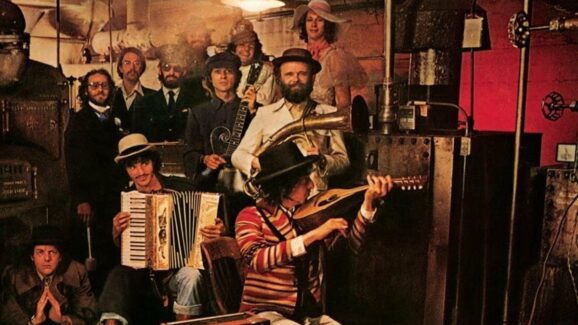With the benefit of half a century of hindsight, Bob Dylan and The Band’s The Basement Tapes (released 6/26/75) would appear to represent the first of a series of revisionist projects overseen by the late Robbie Robertson. As with his archival work on The Band (a/k/a/ ‘The Brown Album) and Stage Fright, the late guitarist/songwriter of the iconic group modifies the famous recordings in such a way that they lose some of their intrinsic charm and impact.
Despite enumerating some minutiae of musician credits, Greil Marcus overlooks those details in his extended essay. Exploring not only the backstory of the recordings, but the background of the music itself, he ignores the hidden agenda of the double set, that is, promoting the The Band: their name on the rise since the reunion tour with Dylan in 1974, their recording fortunes were nonetheless on a proportional downswing at that time.
Shorn of the overdubs and remixes that adorned the selected collection of twenty-four tracks released fifty years ago, the quick succession of thirty-eight cuts comprising The Basement Tapes Raw: The Bootleg Series Vol. 11 more accurately conjures the nurturing ambiance that must’ve arisen from those hallowed sessions convened in Woodstock, NY.
Having worked with Dylan and The Band on 1974’s pre-tour studio project, Planet Waves, mixing engineer Rob Fraboni effectively restores the audio quality of tapes first overseen by multi-instrumentalist Garth Hudson. Still, as the musicians follow the muse in the moment, juxtaposing traditional songs, contemporary roots material and originals of greater or less significance, the sensation is hardly one of separation.
The alternately relaxed and inspired atmosphere the songs and performances radiate is palpably intimate. The wondrous process of rediscovering songs such as “Minstrel Boy” gives birth to their own compositions like “Tears of Rage” (which notably opened The Band’s first album, Music From Big Pink).
Meanwhile, Dylan’s laughter at a couple junctures is reflective of the often absurd sense of humor the six men shared, not just within tunes like “Clothes Line Saga,” but also in the cover photos inside and out (as well as some candid outtakes in the ten-page booklet enclosed with the 2009 double-CD set).
During this time spent with the group once known as the Hawks, Bob Dylan was exploring not only his roots but those of the group he once called ‘gallant knights’ for enduring the backlash to his forays into electric rock on the road in 1966. At the same time, the future Nobel Laureate was making a concerted effort to produce some demos of new material for song publishing purposes.
The aforementioned 2014 vault collection contains most of the best-known tunes from the often bootlegged recordings. In contrast, the five-decade-old release excludes “Quinn the Eskimo (The Mighty Quinn)” and “This Wheel’s On Fire,” both of which were hits in 1968 for British artists Manfred Mann and Julie Driscoll with Brian Auger and the Trinity, respectively.
It’s more than a little notable, too, that the eight cuts featuring The Band by themselves on the 1975 collection preclude inclusion of some lesser-known Dylan compositions. The haunting “I’m Not There,” for instance, is as dense with symbolism and metaphor as any of the songs from Bob’s halcyon ’65-’66 period. And the highly emotive performance of “Sign on the Cross,” is one of the Bard’s most passionate turns at singing on the entire set.
Certainly, with The Basement Tapes Complete now available, it’s possible to experience (almost) first-hand the casual nature of Bob Dylan and The Band’s informal get-togethers during the summer of 1967. But that hardly diminishes the mystique surrounding what is arguably the most unfettered expression extant of these musicians’ chemistry.








